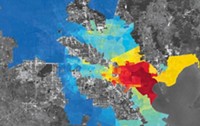Advertisement
Grab your lab coat. Let's get started
Welcome!
Welcome!
Create an account below to get 6 C&EN articles per month, receive newsletters and more - all free.
It seems this is your first time logging in online. Please enter the following information to continue.
As an ACS member you automatically get access to this site. All we need is few more details to create your reading experience.
Not you? Sign in with a different account.
Not you? Sign in with a different account.
ERROR 1
ERROR 1
ERROR 2
ERROR 2
ERROR 2
ERROR 2
ERROR 2
Password and Confirm password must match.
If you have an ACS member number, please enter it here so we can link this account to your membership. (optional)
ERROR 2
ACS values your privacy. By submitting your information, you are gaining access to C&EN and subscribing to our weekly newsletter. We use the information you provide to make your reading experience better, and we will never sell your data to third party members.
Pollution
Satellites can now see air pollution inequality within cities
Study finds that NO₂ levels are about 37% higher in low-income, nonwhite census tracts in Houston
by Katherine Bourzac
August 5, 2020

A new analysis shows that data from a satellite currently orbiting Earth can be used to spot neighborhoods with high levels of nitrogen dioxide air pollution. In Houston, researchers found air pollution inequality was associated with income and race or ethnicity. The researchers also found that adverse weather events intensified inequality (Environ. Sci. Technol. 2020, DOI: 10.1021/acs.est.0c01864).
The initial analysis focused on Houston, but the NO2 data, from a European Space Agency project called TROPOMI (TROPospheric Ozone Monitoring Instrument) cover the globe and are freely available online.
Looking at NO2 differences within cities has been particularly challenging because the gas is short lived. It reacts rapidly with other chemicals in the atmosphere, often leading to the formation of ozone or particulate matter—both of which are health hazards. NO2 levels might be very high next to a freeway or industrial zone, even if the air a kilometer away is clean. This rapid decay makes NO2 inequality difficult to measure without data that have high spatial resolution, says Sally Pusede, an atmospheric chemist at the University of Virginia who led the analysis with Mary Angelique Demetillo, an environmental data scientist at the university.
Ground-based stationary monitors take continuous, high-quality measurements, but they are few and far between. Chemists can fill in the details by driving or flying sensor-laden vehicles or planes around a city for periods of weeks or months.
Satellites, on the other hand, can take ongoing measurements over a large area. But in the past, their spatial resolution hasn’t been high enough to directly measure differences within cities. TROPOMI’s predecessor, OMI, could measure NO2 differences between cities but not within them. TROPOMI’s spatial resolution, 3.5 km by 7 km, yields much finer detail.
To prove that TROPOMI data analysis could distinguish NO2 levels within a city, Pusede wanted to compare it to analysis of high-resolution measurements. So her team started by analyzing data from a mission that flew a sensor-loaded airplane over Houston and other cities. DISCOVER-AQ’s spatial resolution was 250 m by 5 m.
Pusede says her group found good agreement between their analyses of DISCOVER-AQ and TROPOMI data. Both showed that NO2 levels are highest near the Houston Ship Channel, where the petrochemical industry is clustered. Overall, Pusede says, people who live in Houston census tracts where residents are predominantly low income and Hispanic or nonwhite are exposed to NO2 levels that are 37% higher, compared with people who live in census tracts with residents who predominantly are white and have higher incomes. The association with race and ethnicity is stronger than the association with income level, though both are factors.
In addition, severe weather events intensify the air pollution inequality, Pusede says. For example, on Sept. 26, 2018, there was a strong stagnation event in Houston, when lack of air flow allowed pollution to linger. “There was high air pollution across the city, but it wasn’t high for everyone,” she says. That day, the NO2 difference across the census tracts jumped from about 37% to about 80%.
Dylan Millet, an atmospheric chemist at the University of Minnesota who was not involved with the work, hopes that the precedent set by Pusede, Demetillo, and their colleagues will inspire similar analyses of satellite data for other places. Policymakers and community organizers could, in theory, partner with scientists to find out what’s going on where they live. “The analysis is not trivial, but the data are free,” Millet says.
“The real revolution is this gives people more tools to make demands of their policymakers,” says Ronald Cohen, an atmospheric chemist at the University of California, Berkeley. “And it can help policymakers assess whether what they’re doing is working.”
Pusede says she’s now analyzing TROPOMI data from other cities covered by DISCOVER-AQ flights, including Los Angeles, Denver, and New York. And she and other atmospheric chemists are looking forward to the next generation NO2-monitoring satellite, which is expected to launch in 2022. TEMPO, which will be locked in geostationary orbit over North America, will provide hourly measurements. “TEMPO will open up a new world for making policy recommendations about addressing inequality,” Pusede says.





Join the conversation
Contact the reporter
Submit a Letter to the Editor for publication
Engage with us on Twitter